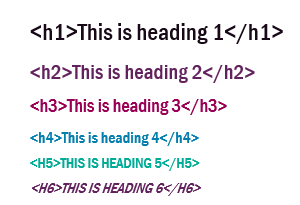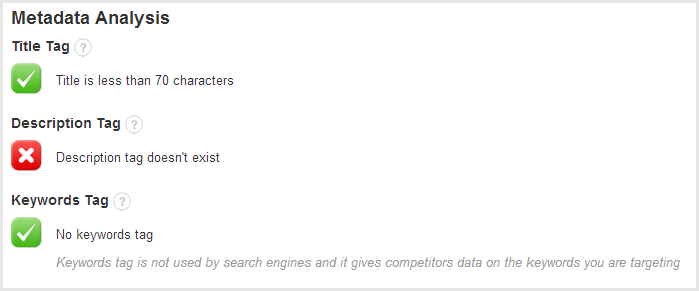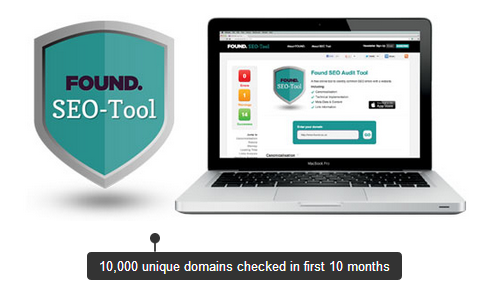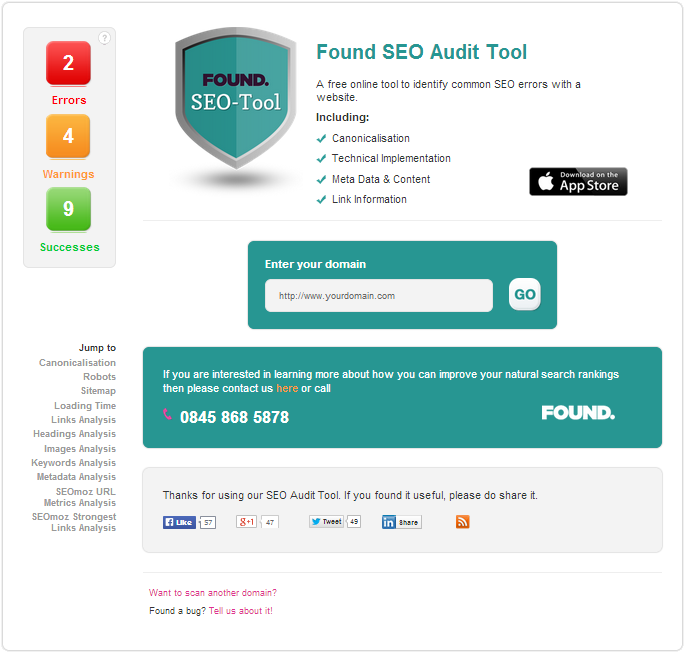Top 7 SEO errors you should fix today
Notice: Undefined variable: post_id in /home/foundco/public_html/wp-content/themes/pivot-child/inc/content-post-single-sidebar.php on line 48

For any SEO strategy to flourish, it’s essential to have a website that is technically equipped to meet the expectations of search engines’ complex algorithms and the spiders that will frequently crawl your site, assuming they have sufficient access.
Technical weaknesses on a website can hinder its chances of ranking highly in the SERPs. Everything from missing title tags to slow load time can have an impact on the overall success of your SEO campaign.
The Found SEO-Tool was created to identify these types of issues and to provide a high-level audit of any webpage instantly. Not only is the tool free, but users are able to run unlimited home or/and internal page URL checks.
A recent study by Randstad Technologies illustrates the shortage of IT and digital professionals that currently exist in the UK, so this tool should come in handy to website owners who don’t want to incur fees from skilled freelance professionals or agencies.
Below we cover 7 common SEO errors websites tend to make and how to resolve them.
SEO errors and how to fix them
1. Sitemap – not found
A Sitemap is a way for a webmaster to feed data to search engines and pass on details about your most important pages, in order of priority.
According to sitemaps.org, whose Protocol 0.9 is adopted by Google, Bing and Yahoo, “a Sitemap is an XML file that lists URLs for a site along with additional metadata about each URL – when it was last updated, how often it usually changes, and how important it is, relative to other URLs in the site. This allows search engines to more intelligently crawl the site.
Using a Sitemap can’t guarantee your webpages will appear in the SERPs, but it is best practice to have one. For more detail on what should be included or how to set one up, Google’s Webmaster Tools offers detailed explanations on creating Sitemaps.
A missing Sitemap can be easily overlooked, but is relatively easy to fix and once you do be sure to submit or resubmit your site to search engines. Both Google and Bing make it relatively straightforward to submit a new sitemap, allowing them to do a fresh crawl of your site.
2. Canonical domain check failed
If you fail a canonical domain check, it means that your homepage is accessible via more than one URL, without having the correct technical instructions in place. Examples of homepage variations: www.found.co.uk, found.co.uk, www.found.co.uk/index.html or Found.co.uk/home.asp
The SEO-Tool carries out canonical checks on individual pages and will help you identify some of the common duplications which can occur. With multiple functioning URLs that display identical content, the effectiveness of inbound link equity can be split, reducing your site’s SEO potential.
If your website has multiple home pages with different URLs, you need to make sure that the correct canonical tags have been implemented or that you have 301 (Moved Permanently) redirects in place to combine the value in one location.
For more information on how to fix canonicalisation issues you can reach out to your Search agency or consult Matt Cutt’s SEO advice on url canonicalization.
3. Page loading time
Even though connection speeds are generally improving, slow loading websites are still an issue for many users. Google stated for the first time, in April 2010, that loading time is factored into their ranking algorithm.
As mobile becomes more and more predominant, it is no surprise that the load time of mobile sites is crucial too. Midway through last year, Google introduced changes in rankings of smartphone search results, which was followed up with an August 2013 post about making smartphone sites load faster than the typical 7 second load time for a mobile page.
In order to help identify some of the issues your site currently has, you can use Google’s PageSpeed Insights tool, which will analyse the reasons your page is running slow and suggest solutions to fix them. Some typical changes include enabling compression, optimising images, minimising JavaScript and avoiding landing page redirects.
Having HTML that is not compressed, simply means that there are unnecessary white spaces and line breaks in your code. Taking out any blank lines so that your HTML is only the actual code helps minimise the size, and is an incredibly easy fix to implement using any online HTML compressor.
4. Header tag analysis
Header tags (< h1 > < h2 > < h3 >) are important for content hierarchy and for communication with the search engines on which headings you want them to prioritise.

Improper use of tags can lead to a very confused content structure. To avoid this, make sure that each page has properly nested and unique < h1 > tag, and that any subheadings use < h2 >and < h3 > tags where appropriate.
It helps to incorporate keywords and phrases into your header tags, because not only do search engines deem them as important when describing a webpage, readers are attracted to the biggest headline on a site just as they would first read the major headline of a newspaper.
5. Alt attribute is missing in x% images
Search engines don’t read images, so it’s essential that you tag them with text, otherwise you may lose out on the opportunity to add relevancy to your page through a keyword rich description.
Just how you would ensure your webpages and blogs are optimised for search, your images alt tag should be relevant and descriptive. Vague descriptions are to be avoided as it can lead to you losing relevant Google Images traffic.
If your image source is men’s jumper, consider making your alt tag as specific as navy blue cashmere men’s jumper at London Fashion Week. Note that descriptive does not mean keyword stuffing and this is important to avoid in your content and alt tags.
6. Metadata analysis
The most important errors to solve in the metadata analysis section are the title tags. They are still widely recognised as one of the most important on page factors for SEO.
Each individual webpage on a site should have its own unique title tag which is concise, optimised appropriately and relative to the content on the page. Title tags should be limited in length to roughly 70 characters (depending on character width), to avoid them becoming truncated. This can be achieved by removing unnecessary stop words such as: a, the, we, with, etc. Be sure to include your primary keywords for that page at the start of the tag whenever possible, as this is known to carry more weight.
Description tags or meta descriptions, are also important, enabling users to view a snippet or overview of what each page is about directly in the search results. Webmasters should focus on producing a well-written 156 character piece, which will tempt people to click through to a site.
Meta descriptions are no longer a ranking factor considered by the search engines but high quality, enticing descriptions can significantly increase the click-through rate to a website. Relevant words to a users search within the description will appear bolded, further reassuring users the page is relevant.
The SEO- tool will only flag an error or warning within the title tag and description tag sections when either the tag is missing completely or exceeds the character limit.

The inclusion of keywords tag will not have a negative impact on your website, but won’t have a positive impact either. The keywords tag is no longer used by search engines to rank your site and should be removed where possible.
7. Keyword analysis
Keyword analysis refers to the body content on your webpage being analysed. Similar to the metadata analysis, it’s essential that the quality of the writing is strong and that the content is unique.
It’s important to have well-written and engaging content for your visitors, but bear in mind that search engines will use the most frequent keywords and phrases within the copy to categorise your page (and site) so it’s important to include relevant keywords where necessary.
This does not mean keyword stuffing or over optimising as doing so will run you the risk of making your page appear spammy. However, too little and search engines might have a hard time understanding which keywords the landing page is trying to rank for.
Why you should download our Free SEO-Tool
Unlike a lot of free tools, Found’s SEO-Tool provides both a mixture of technical, link analysis and content recommendations. The audit also offers valuable information when your hover over the question marks that appear to the right of each heading.

Once the data has been gathered, it can be viewed at any time by either bookmarking a uniquely generated URL from the ‘Save result’ button or by exporting to PDF.
We recently updated the SEO-Tool App, adding some features such as a result filtering for more in-depth reporting and interface updates for both the iPhone and iPad.
Visit our SEO-Tool for a free instant audit
Found is a London-based multi-award-winning digital growth, SEO, PPC, Social and Digital PR agency that harnesses the efficiencies of data and technology and future-thinking to help clients grow their businesses online.
